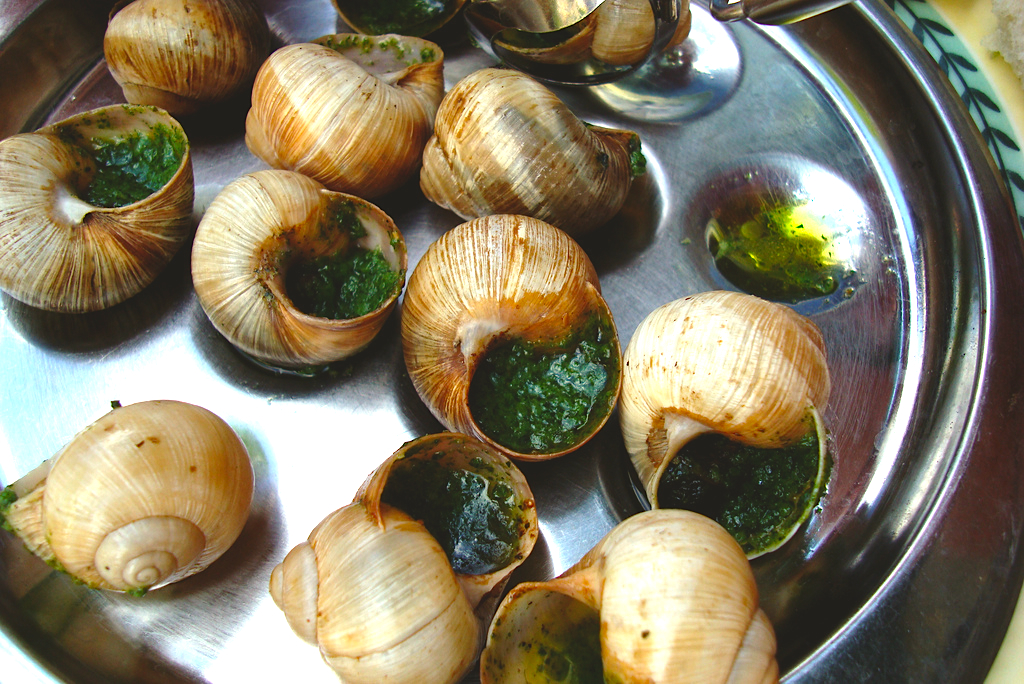Escargots (snails)

Escargots (snails) is a Green food. Green foods are safe to eat as a regular part of a diet.
Category Quotes
Guideline related quotes related to Meat-Exotic and Green throughout Geoff Bond's publications.
Examples of one serving include 3 oz (size of a deck of cards) cooked meat or poultry; 3 oz grilled fish; 1 egg. ~Paleo in a Nutshell p.95
For the meat, poultry, eggs, and fish group, Preferably consume two servings a day of “Green-Green” foods. If unavailable, you can consume two servings a day of “Green” foods. ~Paleo in a Nutshell p.102
For the meat, poultry, eggs, and fish group Restrict total food group servings per session to one. ~Paleo in a Nutshell p.102
For the meat, poultry, eggs, and fish group, Restrict total food group servings per day to two. ~Paleo in a Nutshell p.102
Additional Quotes
Specific references to Escargots (snails) throughout Geoff Bond's publications.
Creatures such as alligator, ostrich, emu, kangaroo, frogs' legs, and escargots (snails). All correspond very well to the kind of animal matter that our Pleistocene ancestors ate all the time. Other exotic foods are making their appearance, particularly bush tucker from Australia, which corresponds to the food traditionally eaten by the Australian Aboriginal. ~Paleo in a Nutshell p.69
Our ancestors were not alone in the savanna. They shared the land with a wide variety of creatures: giraffe, lion, elephant, warthog, rhinoceros, hyena, antelope, gazelle, zebra, baboons, chimpanzees, vultures, eagles, flamingos, and many more. In addition, there were snakes, porcupines, crocodiles, lizards, tortoises, snails, grasshoppers, and a myriad of small mammals, reptiles, and insects. The lakes, streams, and waterholes teemed with many species of freshwater fish, shellfish, frogs, toads, ducks, geese, and other aquatic creatures. ~Deadly Harvest p.13
For Aborigines, The animal food collected would be eggs, turtles, snakes, shellfish, crabs, caterpillars (e.g., the witchety grub and the bogong moth), land snails, and the goanna (a giant lizard). Sweet foods were very rare but much prized. Disproportionate amounts of time were spent on finding a bees' nest to smoke out. Other sweetmeats were the honey ant, gorged with nectar, and "lerp," a sweet insect secretion on eucalyptus leaves. In times of scarcity, grass seeds were collected, winnowed, and ground between two handheld stones. The drudgery of this task was viewed with such distaste that it was only done very rarely. ~Deadly Harvest p.19
At the U.S. Department of Agriculture (USDA), meat is the term applied to the flesh of domesticated mammals, such as cattle, pig, and sheep. More conventionally, this is known as "red meat," which is the designation used here. Similarly, "game" refers to the flesh of any wild land animal, such as wild boar or pheasant. "White meat" refers to flesh taken from domesticated birds, such as chickens, and "seafood" refers to fish and shellfish. We will look at both wild and domesticated sources of animal products. The USDA does not include certain classes of animal foods that were common in our ancestors' diet— the "exotic" categories of reptiles, worms, insects, and gastropods (snails and slugs). ~Deadly Harvest p.58
Many primitive societies eat snails and their shell-less cousins, the slug. The idea to some minds seems grotesque, yet they are a valuable, easily collected source of food. In fact snails have been commonly raised and eaten in the Middle East and Europe for thousands of years. The French, of course, have made a national dish out of snails: "escargots" cooked in garlic and butter are even considered a delicacy. Snail and slug flesh conforms to the Savanna Model, although the French recipe is not ideal nutritionally. ~Deadly Harvest p.63